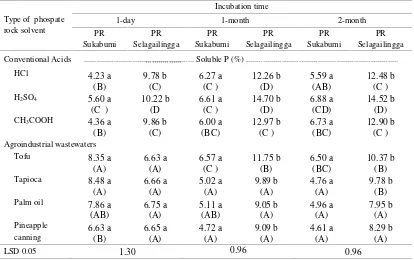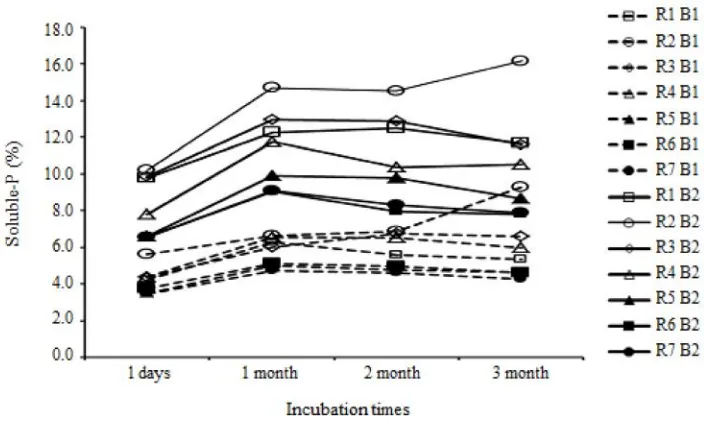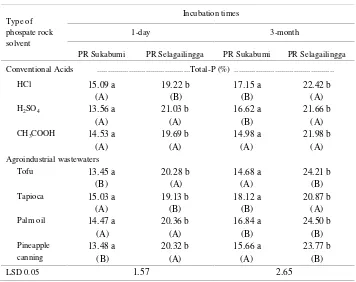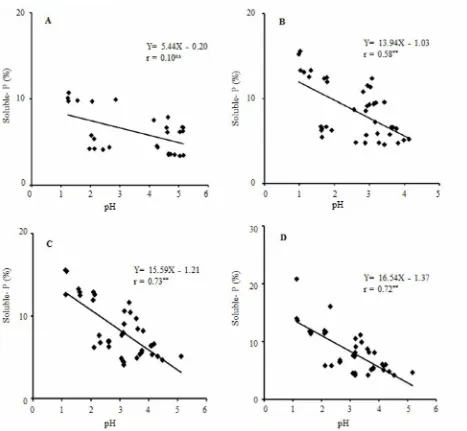43 J Trop Soils, Vol. 19, No. 1, 2014: 43-51
J Trop Soils, Vol. 19, No. 1 2014: 43-51 ISSN 0852-257X
Available online at:
http://journal.unila.ac.id/index.php/tropicalsoil DOI: 10.5400/jts.2014.19.1.43
Potency of Agroindustrial Wastewaters to Increase the Dissolution of
Phosphate Rock Fertilizers
Ainin Niswati, Sri Yusnaini and Sarno
Soil Science Division, Department of Agrotechnology, Faculty of Agriculture, University of Lampung, Jl. Sumantri Brojonegoro No. 1 Bandarlampung, 35145, e-mail:[email protected]
Received 13 September 2013/ accepted 23 December 2013
ABSTRACT
The used of agroindustrial wastewaters are not maximum yet in Lampung Province,althought it can be used as an acid solvent because of its acidic properties. This study was aimed to explore the most potential agroindustrial wastewaters in dissolving phosphate rock through acidulation in the laboratory scale. The experiment was arranged in a factorial.The first factor was origined of phosphate rock (Sukabumi, west Java and Selagailingga, central Lampung) and the second factor was solvent types (agroindustrial wastewaters which were pineapple, tapioca, tofu industry, and palm oil as well as conventional acid solvents which were HCl, H2SO4, and CH3COOH). The incubation
processes were 0, 1, 2, and 3 months. The results showed that agroindustrial wastewaters that have the highest potency to solubize phosphate rock was industrial tofu wastewaters and followed by industrial wastewaters of tapioca, palm oil, and pineapple. Both the conventional acid and agroindustrial wastewaters solvent had a big potency to solubilize phosphate rock, however, its highest soluble P-value did not match with the ISO criteria for phosphate fertilizers Quality I (SNI) because it did not reach the solubility of 80% of its total P2O5, but it has been qualified as a fertilizer both the quality phosphate A, B, and C (SNI).
Keywords: Acidulation, agroindustrial wastewater, P fertilizer, phosphate rock
Natural phosphate rocks (PR) are an important natural material traditionally used for the production of P (phosphorus) fertilizers. Traditional P fertilizer is produced based on chemical processing of a insoluble high-grade mineral phosphate which includes an energy intensively with sulfuric acid at a high temperature (Van Straaten 2002). This process is environmentally undesirable, it is not least because of the release of contaminants into the main product, gas streams and by-products.
Natural PR’s have been recognized as a valuable alternative for P fertilizers and as a cheaper source of phosphate fertilizer for crop production (Ghosh 1999). Phosphate rock is not available for plant where the soil pH is greater than 5.5-6.0 and even when conditions are optimal, plant yields are lower than those obtained with soluble phosphate (Khasawneh and Doll 1978). The use of PR as fertilizer is determined by the mineral properties, solubility, grain size, free carbonate content, total P2O5 content in PR, and type of deposit. Although
PR can be used directly on the soil, but its availability to plants is very slow (Zapata and Zaharah 2002) and the effectiveness of PR as a fertilizer is limited by its low dissolution rate (Hamdaliet al. 2010), so it needs to be processed chemically to accelerate its solubility. Phosphate rock is generally found in the form of calcium phosphate [Ca3(PO4)2] or fluorapatite [3Ca3(PO4)2CaF2], these compounds are generally slow release (Havlinet al. 2005). Commonly, the phosphate fertilizers are produced by acidulation (Budi and Purbasari 2009).
One alternative to accelerate the solubility of PR is by utilized wastewaters as a byproduct of various industrial treatments of agro-productsof tapioca, palm oil processing industry, pineapple canning industry, and the tofu industry. Several studies have shown that these wastewaters have a low pH. Vassilev and Vassileva (2003) reviewed that there was a potency of agro-industrial waste to solubilize PR, besides they have low pH, they also release some organic acids produced by microorganisms.
Selagailingga, Central Lampung, and many agroindustrial wastewaters by product can be created as a cheaper alternative for dissolution of PR as the basis for the fertilizer manufacture. The establishment of local PR can be used to overcome the problem of high price for importing PR from abroad.
The purpose of this study was to find the potency of local agroindustrial wastewaters to solubilize local PR in order to create P-fertilizer and for find the optimum incubation time for solubilizing P2O5 from PR.
MATERIALS AND METHODS
Phosphate Rock and Agroindustrial Wastewaters Uses
Phosphate rocks were taken from Sukabumi District, West Java and Selagai Lingga, Central Lampung District, Lampung Province. The performances of PR used are shown on Figure 1. Agroindustrial wastewaters were taken from several locations of agroindustrial factory such as center of tofu industry in Bandarlampung, CV Bumi Waras for tapioca and palm oil agroindustrial wastewaters, and PT Great Giant Pineapple for pineapple industrial wastewaters. The PR and agroindustrial wastewaters characteristics are shown in Table 1 and 2.
Research Design
Treatments were design by a factorial in a randomized block design. The first factor was kinds of solvent, consist of three conventional solvents
Figure 1. Texture differences between phosphate rock from Selagailingga, Central Lampung (A) and Sukabumi, West Java (B).
A B
Variable Agrondustrial wastewaters
Tofu Palm oil Tapioca Pineapple canning
pH 3.76 4.0 4.27 3.08
COD (mg L-1) 9,900 34,720 10,525 27,850
BOD (mg L-1) 925 21,280 743 1,295
P-total (%) 0.00054 0.0008 0.0025 0.00037
N-total (%) 0.07 0.03 0.03 0.03
1
Tabel 1. Phosphate rock characteristics. Origin of
phospate rock
pH Total-P (%)
Soluble-P (%)
Sukabumi 5.76 14.24 3.78
Selagai Lingga 5.96 25.63 7.08
1
Tabel 2. Characteristics of agroindustrial wastewaters used for asidulating phosphate rock.
i.e. hydrochloric acid (HCl), sulfuric acid (H2SO4), and acetic acid (CH3COOH) as well as agroindustrial wastewaters of tofu, palm oil, tapioca, and pineapple caning. The second factor was origin of PRi.e. from Sukabumi and Selagai Lingga. Every treatment was incubated by soaking the PR with acid solvent in 0, 1, 2, and 3 month. Every treatment was done by three replications.
Phosphate Rock Incubation
Phosphate rocks were milled and then sieved with a 3 mm siever. Selected agroindustrial wastewaters were analyzed its pH, N, total-P, BOD (biological oxygen demand), and COD (chemical oxygen demand). Five hundreds gram of the powder of rock phosphate (less than 3 mm in diameter) were submerged with every fresh agroindustrial wastewaters as well as with conventional acid solvent until all PR’s were drowned. Submerged rockposphate were covered tigthly and incubated according to the treatments
i.e.one day, one-, two-, and three-month. All PR were incubated at room temperature.
Selagailingga
45
J Trop Soils, Vol. 19, No. 1, 2014: 43-51Sampling and Analyzing Incubated Phosphate Rock
Samples were taken by spatula in five replications from five different sites in the incubated container, and then it were mixed as a composite sample. Samples were taken in accordance to incubation times. Incubated wet samples were dried up to one week with room temperature until dry. For further analysis, the incubated PR after oven were milled and analyzed. Every sample were analyzed the characteristic of its available-P (citric acid 2%), total-P (HCl 25%), and pH.
Statistical Analysis
Data obtained were analyzed by analysis of variance (ANOVA) and separation of main differences were tested by Least Significance Difference test at 5% level. Correlation between variable was done for study the relationship between variable.
RESULTS AND DISCUSSION Changes of Phosphate Rock pH after Acidulated
One-day submerged. After one day incubation, pH of PR’s from Sukabumi were significantly higher than that from Selagailingga when submerged with H2SO4 or CH3COOH (Table 3). All of PR submerged with conventional solvent had significantly lower pH than that all agroindustrial wastewaters. Almost the same thing was obtained in the PR of Selagailingga and oil palm wastewater which had a higher potency in decreasing pH than tapioca and pineapple wastewaters as a solvents of phospahte rock.
One-Month Submerged. After acidulation of PR by acid solvent or agroindustrial wastewaters one month, the increasing of pH were higher compared to one days incubation (Table 3). in dissolution of PR with conventional acid solvent and agro-industrial wastewaters PR from Sukabumi had a higher pH than Selagailingga excepted by solvent from palm oil and pineapple canning wastewaters. The same as the submerged of one day, the H2SO4 and CH3COOH solvent had the highest acidity in submerged PR that was indicated by the low pH compared to the other solvents.
Two-Month Submerged. The pH value of PR in the two month submerged had the same value as one month submerged altought the pH value of the PR from Sukabumi was higher than Selagailingga, except when it had dissolved by a palm oil and pineapple canning wastewaters. Phosphate rock
from Sukabumi had a greater potency for acidifying by palm and pineapple canning wastewaters, while the pH of phosphate rock from Selagailingga did not significantly decrease by agroindustrial wastewaters solvent.
Three-Month Submerged. After 3 months submerged by various solvents, pH of PR from Sukabumi and Selagai Lingga showed no significantly difference with LSD test, whereas other results were the same as submerged at 1 and 2 months (Tables 3).
Variation in pH during Incubation
During incubation of 1 day to 1 month pH significantly increased pH and afterwards (at 2 and 3 months) were also likely to increase, but with a small gradient (data not shown).Figure 2 also shows that the pH of the PR solution from Sukabumi had a higher pH compared to PR from Sukabumi. Conventional acid solvent, H2SO4, had a very significantly higher than the other solvents in dissolving P.
Changes in Soluble-P from Phosphate Rocks One-day submerged. Results of one day incubation showed that soluble PR from Sukabumi had significantly higher pH than the original PR of Selagailingga (Table 4). Acidulation with H2SO4 significantly increased P-soluble compared to other solvents for both PR’s. At day one,agroindustrial wastewaters solvent had the ability to dissolve phosphate as good (not significantly different) as conventional acid solvent CH3COOHi.e.industrial tofu wastewater. From these data it can be presumed that the tofu wastewater had a better potential than other wastewaters.
One-Month Submerged. After acidulation of PR by acid solvent or wastewaters agro-industry during the first month, there was an increase compared to soluble P at one day submerged (Table 4). Dissolution P of PR from Sukabumi was significantlly lower than the original PR of Selagailingga. Dissolution of PR with H2SO4 conventional solvent, remains soluble P-value was higher than the other unless the acid CH3COOH with wastewaters industry that it was not significantly different from the same as in the acidulation 0 months
.
agro-A
N
is
wa
ti
et
a
l.:
A
gr
oi
n
du
st
ri
a
l W
as
te
w
at
er
s
to
In
cr
ea
se
S
o
lu
b
le
-P
Median values followed by the same letter in the same row and column are not significantly different at the level of 5% LSD. Lowercase was read vertical lyand capital letter (in parentheses) was read horizontally.
47 J Trop Soils, Vol. 19, No. 1, 2014: 43-51
industral wastewaters that was not significantly different from the same as one-day acidulation. Of the three kinds of conventional solvents, H2SO4 remains as the best solvent while HCl and CH3COOH were equally lower potency than H2SO4. In addition, from Table 4 it can be seen that the industrial tofu and tapioca wastewaters had high potency as a solvent for PR acidulation compared to oil palm industry and pineapple canning wastewaters.
Three-Month Submerged. At three months of submerged there was no interaction effect between the origin of PR and solvent for P-soluble acid (Tables 5 and 6). P-soluble from PR origin of Selagailingga was significantly higher than Sukabumi. While conventional acid solvent H2SO4 was
Table 5. Soluble P from two kind of phosphate rock after 3 months incubation.
Table 6. Soluble P from two kind of phosphate rock after 3 months incubation. Table 4. Interaction effect of phosphate rock that were acidulation by agroindustrial wastewater and
acid solvent on soluble-P under different incubation times.
Mean values followed by the same letter in the same row and column are not significantly different at the level of 5% LSD. Lowercase was read vertical and capital letter (in parentheses) was read horizontal.
significantly higher than the other solvents in dissolving P.
Variation of Soluble-P during Incubation
Figure 2 shows maximum values of soluble-P generally occured at 1-month after incubation. The soluble-P increased from one-day submerged up to one-month, then stable and tend to decreased until
Values followed by the same letter are not significantly different at the level of 5% LSD.
Values followed by the same letter are not significantly different at the level of 5% LSD.
Type of phospate rock solvent
Conventional Acids ...,,,,,,,,,,,,,,,,,... Soluble P (%) ...
HCl 4.23 a
LSD 0.05 1.30 0.96 0.96
Phosphate rock origin
Soluble-P (%) 3 months incubation
Sukabumi 5.81 a
Selagai Lingga 10.62 b
LSD 0.05 3.18
Figure 2. Changes in soluble-P during the incubation periods from two kinds of phosphate rocks. B1= phosphate rocks of Sukabumi, B2= phosphate rocks of Selagailingga, R1= HCl, R2= H2SO4, R3 = CH3COOH, R4 = tofu wastewaters R5 = palm oil wastewaters, R6 = tapioca wastewaters and R7 = pineapple canning wastewaters.
three-months. It indicated that equilibrium reaction between PR with solvent was already stable. Changes in Total-P Phosphate Rocks after Acidulation
One day submerged. Table 7 shows that the PR from Sukabumi had a lower P-total than that of Selagailingga. While the PR from Sukabumi had the highest P-total with pineapple canning wastewaters and the lowest by HCl solvent.
One- and Two-Month Submerged. Tables 8 shows that the total-P was depending on the origin of the PR. It is very clear that the P-total of PR Selagailingga was significantly higher than of Sukabumi.
Three-Month Submerged. Table 7 shows that the PR Sukabumi had lower total-P than of Selagailingga. Furhtermore, total-P remaining after acidulation by pineapple canning and tofu industrial wastewaters was high as at one-day incubation.
During three-month incubation, total-P was changed in which it would increase after one-month incubation (Figure 4). It was in line with maximum P-solubilization occured during one-month incubation.
Discussion
Based on the results obtained, acidulation of PR with agro-industry wastewater and conventional acid solvent would have highest dissolution P after one-month of incubation. After one-month, P-soluble
would decline, except in the treatment of PR Selagailingga and H2SO4 acid solvent that was still a bit up to two-months. This is likely due to (1) the availability of H+ ion to dissolution PR increased and mixed rock phosphate released monovalent H2PO4 -in concomitant with -increas-ing of pH and divalent HPO-2occured (2) the reaction equilibrium dissolution of PR has been achieved so that the reaction product in the form of H2PO4- and HPO-2 has reached the maximum. Different with research of Al-Oud (2011) when PR mixed with calcareous soil and acid solvent such as Organic manure, citric acid, oxalic acid, or EDTA would increase in concomitant with 90 days incubation.
49 J Trop Soils, Vol. 19, No. 1, 2014: 43-51
Table 7. Interaction effect of phosphate rock that were acidulation by agro-industrial wastewater and acid solvent on total-P under different incubation times.
Mean values followed by the same letter in the same row and column are not significantly different at the level of 5% LSD. Lowercase was read vertical and capital letter (in parentheses) was read horizontal.
Table 8. Total-P of phosphate rock after one-and two-months incubation
Values followed by the same letter are not significantly different at the level of 5% LSD.
quality must meet the requirements in accordance with the SNI, when the fertilizer product will be sold. Significantly increasing in pH during incubation was occured. On the solubility of P from PR Selagailingga, which was caused by the presence of Ca2 +increasing the pH became alkaline, so it did not dissolved P anymore. As in soil, Kanabo and Gilkes (1986) and Soelaeman (2008) reported that increasing of soil pH resulted in decreased dissolution of PR and contact period affected in dissolution.
Of the four types of wastewater used, each had a potentially for dissolution P from PR, all of the acids wastewater had lower pH. However, from the results of research conducted, dissolution of P by tofu wastewater was not comparable with the
acid solvent. This is due to the pH of the agro-industrial wastewater was higher than the acid solvent. Of the seven types of the acid solvent, H2SO4 was the highest in dissolution of PR. Although solvent H2SO4 was better as solvent for PR, but it was not qualified as a Phosphate Fertilizer Quality A according to SNI 2005 (BSN 2005).
At one-day incubation dissolution of PR by all solvent have occurred (Figure 2). This happens because of shortly after submerged, chemical reaction was action by protons released from wastewater. In accordance with Sauvé and McBride (1998) that activity of phosphate have relationship with pH where highest solubility at low pH and gradual decreased with increasing pH. In Type of
phospate rock solvent
Incubation times
1-day 3-month
PR Sukabumi PR Selagailingga PR Sukabumi PR Selagailingga
Conventional Acids ...Total-P (%) ...
Palm oil 14.47 a
(A)
LSD 0.05 1.57 2.65
Phosphate rock Total-P (%) Total-P (%)
1-month incubation 2-month incubation
Sukabumi 15.61 a 15.89 a
Selagai Lingga 21.76 b 22.25 b
LSD 0.05 2.47 2.48
addition Vassilevet al. (2006) reported that beside of agroindustrial waste have low pH, it also released some organic acid by the activities of microorganism. Soluble-P from PR Selagailingga were higher than that from Sukabumi. This is because the initial percentage level of P2O5 in PR Selagailingga was 25.63% where it was higher than the PR Sukabumi which was only 14.24% (Table 1). It is proved that the levels of P2O5 in PR to be one of the factors for dissolved P. Shipitalo et al. (2012) mention that different types of materials would produce different yield. This is in line with research reported by Kawusulan (2007), that the high solubility of P is also influenced by the total P content of PR itself.
The concentration of P in natural PR that is used will affect the solubility of the phosphate in solution.
CONCLUSIONS
51 J Trop Soils, Vol. 19, No. 1, 2014: 43-51
phosphate fertilizer I (SNI) because it has not reached the solubility of 80% of the total P2O5, however it has been qualified as a good quality for natural phosphate fertilizer grade A, B, and C.
REFERENCES
Al-Oud SS. 2011. Improving phosphorus availability from phosphate rock in calcareous soils by amending with: organic acid, sulfur, and/ or organic manure.Ozean J Appl Sci 4: 227-235.
Budi FS and A Purbasari. 2009. Pembuatan pupuk fosfat dari batuan fosfat alam secara acidulasi. Teknik 30 (2): 93-97 (in Indonesian).
BSN [Badan Standardisasi Nasional]. 2005. Pupuk fosfat alam untuk pertanian, 14 p (in Indonesian). Ghosh PC. 1999.Chemistry and Agronomic Evaluation
of Phosphatic Fertilizers, Agrotech Publishing Academy, Udaipur.
Hamdali H, A Smirnov, C Esnault, Y Ouhdouch and MJ Virolle. 2010. Physiological studies and comparative analysis of rock phosphate solubilization abilities of Actinomycetales originating from Moroccan phosphate mines and of Streptomyces lividans. Appl Soil Ecol44: 24-31.
Havlin JL. SL Tisdale, JD Beaton and WL Nelson. 2005. Soil Fertility and Fertilizers: An introduction to Nutrient management. Seven Edition. Pearson Prentice Hlll. New Jersey. 515 p.
Kanabo IAK and RJ Gilkes. 1986. The role of soil pH in the dissolution phosphate rock fertilizers.Fertil Res 12: 165-174.
Khasawneh FE and EC Doll. 1978. The use of phosphate rock for direct application to soils.Adv Agron 30: 159-206.
Kawusulan RI. 2007.Pengaruh Pemberian Fosfat Alam dan Pupuk N Terhadap Kelarutan P, Ciri Kimia Tanah, dan Respon Tanaman pada Typic Dystrudeps Darmaga.Master Thesis. Sekolah Pasca Sarjana. Institut Pertanian Bogor, Bogor. 78 p (in Indonesian).
Sauvé S and M McBride.1998. Lead Phosphate Solubility in Water and Soil Suspensions.Environ Sci Technol 32: 388-393.
Shipitalo MJ, JVBonta and LB Owens. 2012. Sorbent-amended compost filter socks in grassed waterways reduce nutrient losses in surface runoff from corn fields. J Soil Water Conserv 67: 433-441. doi: 10.2489/jswc.67.5.433.
Soelaeman Y. 2008. Efektivitas pupuk kandang dalam meningkatkan ketersediaan fosfat, pertumbuhan dan hasil padi dan jagung pada lahan kering masam. J Tanah Trop 13: 41-47 (in Indonesian). Van Straaten P. 2002. Rocks for crops: Agrominerals of
sub-Saharan Africa. ICRAF, Nairobi, Kenya, 338 pp.
Vassilev N and M Vassileva. 2003. Biotechnological solubilization of rock phosphate on media containing agro-industrial wastes.Appl Microbiol Biotechnol 61: 435-440. doi 10.1007/s00253-003-1318-3
Vassilev N, A Medina, R Azcon and M Vassileva. 2006. Microbial solubilization of rock phosphate onmedia containing agro-industrial wastes and effect of the resulting products on plant growth and P uptake. Plant Soil287: 77-84.




